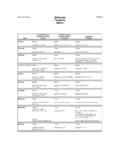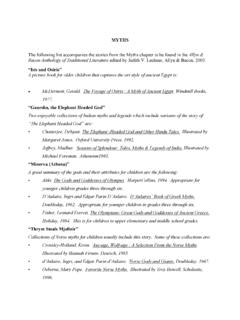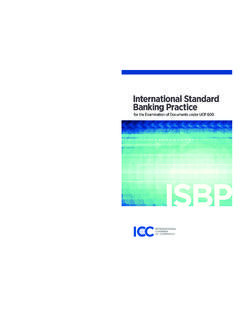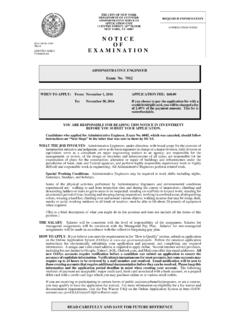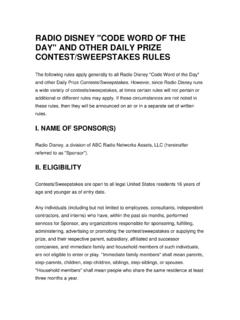Transcription of Thyroid Function Tests - Auburn University
1 Thyroid Function TESTST hyroid Stimulating Hormone (TSH):The Thyroid stimulating hormone (TSH) assay measures the concentration of thyroidstimulating hormone in the serum. TSH assays have been classified by "generation"based on the functional sensitivity of the assay, , the lowest concentration at which theassay is able to maintain an inter-assay precision, expressed in terms of percentcoefficient of variation (%CV), of 20% or less. Virtually all TSH assays currently in useare either second or third generation, with functional sensitivities of to IU/mLand to IU/mL, respectively; thus third generation assays are an order ofmagnitude more sensitive than second generation assays (sTSH). TSH is recognized asan exquisitely sensitive indicator of Thyroid status and thus TSH assays (second or thirdgeneration) have been widely adopted as the front-line Thyroid Function test.
2 Inambulatory patients with intact hypothalamic and pituitary Function , a normal TSH resultexcludes hypo- or hyperthyroidism; whereas elevated and suppressed TSH results arediagnostic of hypo- and hyperthroidism, respectively. Abnormal TSH results aregenerally confirmed with a complementary determination of Thyroid hormone levels asdescribed third generation assays have been recognized as consistently superior to secondgeneration assays with their ability to accurately distinguish between normal andsuppressed results. Furthermore, third generation assays distinguish between mildlysuppressed and profoundly suppressed states. These assays, therefore, provide a powerfultool for estimating the severity of hyperthyroidism, for distinguishing between frankhyperthyroidism (TSH values below to IU/mL) and the effects of non-thyroidal illness and certain drugs among hospitalized patients that suppress TSH levelsin the absence of Thyroid disease (sick euthyroid disease), and for optimizing normal individuals, TSH levels typically are between and mU/ml.
3 TSH isunder negative feed back control by the amount of free Thyroid hormone (T4 and T3) inthe circulation and positive control by the hypothalamic Thyroid -releasing hormone(TRH). Thus in the case of Thyroid hormone deficiency (hypothyroidism) the TSH levelshould be elevated. A value greater than 20 mU/ml is a good indicator of primary failureof the Thyroid gland. A value of between 5 and 15 is a borderline value that may requiremore careful evaluation. If the hypothyroid state is due to failure of the pituitary gland(TSH) or the hypothalamus (TRH), the values for TSH may be low, normal oroccasionally in the borderline range. Thus a TSH above 15 is very good evidence forprimary hypothyroidism and a value below 5 is very good evidence against primaryhypothyroidism.
4 The presence of low Free T4 with a TSH of less than 10 stronglysuggests a pituitary or hypothalamic etiology for the hypothyroidism (secondaryhypothyroidism). The TSH alone cannot be used to screen for secondary hypothyroidismand usually requires a measurement of Thyroid hormone levels to be high levels of free Thyroid hormone will suppress TSH levels, in almost all casesof hyperthyroidism the TSH values will be less than and usually less the TSH is a very effective tool to screen for hyperthyroidism, the degree ofsuppression of TSH does not always reflect the severity of the a measurement of free Thyroid hormone levels is usually required in patientswith a suppressed TSH level.
5 If the Free T4 is normal, the free T3 should be checked asit is the first hormone to increase in early levels can also be used to effectively monitor patients being treated with thyroidhormone. However, it should be noted that TSH results may be misleading during theseveral months required for full equilibration of Thyroid physiology following initiationor significant alteration of a treatment regimen. Total or free T4 generally serve as thefront-line assays during this period. Once equilibration has occurred, high TSH levelsusually indicate under-treatment, while low values usually indicate , abnormal TSH values should be interpreted with the measurement of free thyroidhormone before modifying therapy because serum Thyroid hormone levels change morequickly than TSH levels.
6 Thus patients who have recently been started on thyroidhormone, or who have been noncompliant until shortly before an office visit may havenormal T4 and T3 levels, though their TSH levels are still elevated. TSH levels may beaffected by acute illness and several medications, including dopamine andglucocorticoids. Decreased (low to undetectable) in Grave's Disease Increased in TSH-secreting pituitary adenomas (secondary hyperthyroidism), PRTHand in hypothalamic disease with increased thyrotropin (tertiary hyperthyroidism) Elevated in hypothyroidism (along with decreased T4) except for pituitary andhypothalamic disease Mild to modest elevations in patients with normal T4 and T3 levels indicates impairedthyroid hormone reserves and incipient hypothyroidism (subclinical hypothyroidism) Mild to modest decreases in patients with normal T4 and T3 levels indicatessubclinical hyperhyroidismThyrotropin releasing hormone (TRH)Prior to the availability of sensitive TSH assays, thyrotropin releasing hormone (TRH)
7 Stimulation Tests were relied upon for confirming and assessing the degree of suppressionin suspected hyperthyroidism. Typically, this stimulation test involves determining basalTSH levels and levels 15 to 30 minutes after an intravenous bolus of TRH. Normally,TSH would rise into the concentration range measurable with less sensitive TSH assaysthat could provide useful information from the profile of increase even if they were notsensitive enough to measure baseline values. Third generation assays do not have thislimitation and thus TRH stimulation is generally not required when third generationassays are used to assess degree of suppression. TRH-stimulation testing howevercontinues to be useful for the differential diagnosis of secondary (pituitary disorder)and tertiary (hypothalamic disorder) hypothyroidism.
8 Patients with these conditionsappear to have physiologically inactive TSH in their circulation that is recognized byTSH assays to a degree such that they may yield misleading, "euthyroid" TSHresults. The TRH-stimulation test produces a very characteristic sluggish rise in TSHvalues. Helpful in diagnosis in patients with confusing TFTs. In primary hyperthyroidismTSH are low and TRH administration induces little or no change in TSH levels In hypothyroidism due to end organ failure, administration of TRH produces aprompt increase in TSH In hypothyroidism due to pituitary disease administration of TRH does not producean increase in TSH In hypothyroidism due to hypothalamic disease, administration of TRH produces adelayed (60-120 minutes, rather than 15-30 minutes) increase in TSHT otal T4 (TT4) and Free T4 (FT4)T4 assays complement TSH assays, and are used to confirm a Thyroid disorder when thisis suggested by an abnormal TSH result.
9 Furthermore, T4 assays may become the front-line assays in conditions that are known to possibly compromise the reliability of TSHresults. Several months may be required for the dynamics of the regulatory mechanism(along the hypothalamic-pituitary- Thyroid axis) to fully equilibrate after a treatmentregimen is initiated or significantly altered; during this time TSH results may bemisleading. Secondary (hypothalamic disorder) and tertiary (pituitary disorder)hypothyroidism are other conditions in which TSH results may be misleading, and thedifferential diagnosis is likely to rely on T4 (Free T4) results complemented by thecharacteristic profile of TSH results obtained during a TRH-stimulation testingprocedure.
10 (See TSH).The total T4 test measures the concentration of thyroxine in the serum, including both theprotein bound and free hormone. The total (but not the free) hormone concentration isdependent on the concentration of Thyroid transport proteins, specifically Thyroid bindingglobulin (TBG), albumin, and Thyroid binding prealbumin (transthyretin). Thus anyconditions that affects levels of Thyroid binding proteins will affect the total (but not thefree) T4 hormone levels. For example, estrogens and acute liver disease will increasethyroid binding, while androgens, steroids, chronic liver disease and severe illness candecrease it. Also, while TT4 is usually elevated in hyperthyroidism, it misses 5% ofcases that are due to triiodothyronine (T3) toxicosis (see below).






